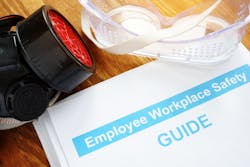Several risks can put your workplace and staff at risk. These include, but are not limited to, fire, earthquakes and even criminal activities, such as burglary and robbery. If you consider the costs of these risks, it's easy to see why it's important to keep the workplace safe and secure.
7 Tips to Keep Your Workplace Secure
Workplace safety starts with a culture of awareness and responsibility. Here’s what you need to do.
1. Identify and Address Workplace Hazards
Knowing what potential threats exist can help make your workplace safer. Many different types of hazards can occur in the workplace, including chemical spills, electrical fires, gas leaks and more. By identifying these hazards and figuring out how to address them, you can ensure that they won't be a problem in the future.
After identifying potential hazards in your workplace, you must come up with solutions for each one. These solutions can help prevent accidents from occurring in the first place or help minimize their damage if it happens.
2. Implement Robust Security Measures
Once you know what kind of threats you're up against, you can start thinking about how to mitigate them. This is where having an up-to-date inventory of your assets comes into play. Knowing what assets you have—both physical and virtual—will help determine the level of protection they require and what kinds of procedures need to be put in place.
For example, confidential data on laptops or other mobile devices must be encrypted. Alternatively, you could implement multi-factor authentication to protect the contents from unauthorized access. You can also make your office environment safer by installing CCTVs, alarm systems and locks on doors and windows to ensure that unauthorized people can't get into your building.
3. Report Unsafe Working Conditions
Unsafe working conditions can lead to accidents and injuries, negatively impacting your employees’ and your business’ performance. It's vital to ensure that everyone is safe at work, but it's even more crucial to make sure your employees feel safe enough to report unsafe working conditions.
This means helping your employees understand their rights in the workplace and know how to report any issues and concerns they have. These can range from the physical integrity of the office structures to harassment cases that employees experience. Whatever the case, you need to create a safe space, encouraging them to speak up and help improve workplace safety.
4. Regularly Check Safety Equipment and Structures
Regularly check equipment and structures in your workplace to ensure they are functioning properly. Signs of damage or wear and tear call for thorough checks. This practice can help prevent accidents due to faulty equipment.
For example, check if your building’s fire alarms are working properly by testing them weekly or monthly. Fire extinguishers must be in good condition and accessible. Make sure windows aren’t broken or damaged, so they can be easily opened if there is a fire emergency. If possible, position them so they open away from the building rather than inwards.
5. Conduct Proper Safety Training Sessions
Company policies, procedures and practices all work together to create a safe and secure workplace. With that, it's important to disseminate these to your employees properly.
Organizing proper safety training sessions can make the workplace safer and more secure. Many employers offer annual safety training courses that focus on topics such as fire safety, first aid, CPR, management of hazardous materials and workplace violence prevention. These classes help employees understand their roles in ensuring their safety, as well as the safety of their coworkers and visitors.
6. Provide Easy Access to Emergency Egress
The most important thing you can do to help your employees during a disaster is to provide easy access to emergency exits. This means they should be clearly marked and well-lit, so employees know where to go during egress. You may also want to consider installing panic buttons or other alarm systems, so people can send distress calls if there's an emergency.
You must also install emergency doors that can withstand natural disasters so that your employees can safely evacuate the premises.
7. Keep Improving Your Security System and Safety Protocols
You must continually and proactively improve the security and safety of your commercial building. For example, onboarding new hires must be given the proper training on using security systems and what to do in case of emergencies. You should also replace outdated systems to protect your organization against digital threats like cyberattacks and ransomware.
Don’t expect a single layer of protection to be completely impenetrable. Instead, you should always be looking for more effective ways to improve your security protocols and the technology that backs them up.
This could mean adding additional devices or software to make sure there are multiple layers of protection in place. It could also mean building multiple forms of security into your system so that if one layer fails, another will catch it and prevent something bad from happening.
Safety at All Times
From natural disasters to man-made threats, the world is full of danger. However, using the right workplace security technology with simple processes and procedures can help keep your workplace safe. You can even double up your safety with the right infrastructure to keep your employees and customers safe from harm.
While it's impossible to eliminate every potential threat, you can take specific precautions to minimize the chances that security vulnerabilities will be exploited by malicious entities and the potential damage that disasters pose.
About the Author:
Diana San Diego has over 15 years of experience in the architectural glazing industry and over 17 years of experience in public relations and marketing. As the Vice President of Marketing at SAFTI FIRST, O’Keeffe’s Inc. and Titan Metal Products, she oversees the advertising, content management, media relations, promotional activities and communication initiatives for these companies.
About the Author

Contributed Author
BUILDINGS partners with industry experts to bring you contributed content covering the hot topics for building owners and facility professionals.
